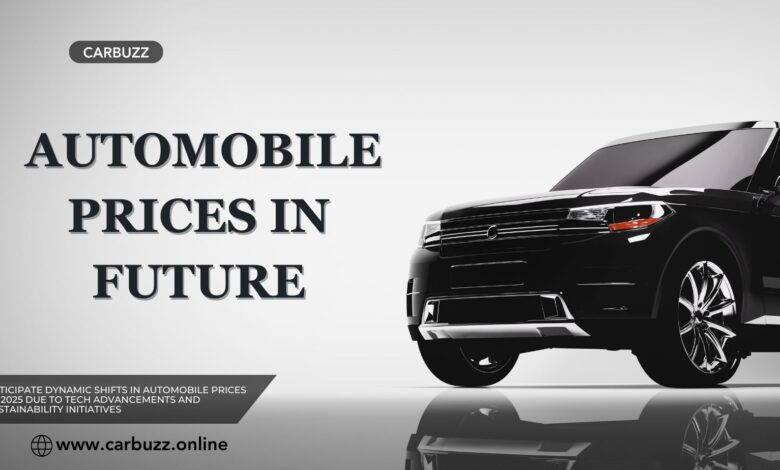Future automobile prices: what can we expect in 2025?

The automobile price industry has always been subject to continuous evolution, driven by technological advancements, changing consumer preferences, and economic factors. As we approach 2025, it becomes crucial to explore future trends in automobile prices. In the upcoming piece, we shall delve into an array of elements that hold the power to shape vehicle pricing and profoundly affect the total expenses associated with automobiles.
1. Current Automobile Industry Trends:
1.1 Electric Vehicles (EVs) on the Rise:
Amid a growing emphasis on sustainability and the drive to reduce carbon emissions, the market for electric vehicles has experienced a remarkable surge in demand. As electric vehicle technology continues to mature, we can expect a wider range of EV options in the market, catering to various price points.
1.2 Advancements in Autonomous Driving:
Autonomous driving technology is rapidly progressing, leading to enhanced safety and convenience. As self-driving features become more commonplace, including such advanced technology may impact automobile prices.
1.3 Shift in Consumer Preferences:
Consumers’ preferences have shifted towards more spacious and versatile vehicles like SUVs and crossovers. Manufacturers are responding to this demand, which may influence pricing strategies.
2. New Future Automobile Prices:
2.1 Tesla Model 3:
Future Automobile Prices Projection:
$40,000
Features:
- All-Electric Range: Impressive electric range of over 300 miles per charge.
- Autopilot Capability: Advanced driver-assistance system for semi-autonomous driving.
2.2 Toyota Prius Prime:
Future Automobile Prices Projection:
$28,000
Features:
- Plug-In Hybrid: Offers both electric and gasoline power options for increased efficiency.
- Advanced Safety Suite: Equipped with Toyota Safety Sense for enhanced safety features.
2.3 Ford Mustang Mach-E:
Future Automobile Prices Projection:
$50,000
Features:
- Electric Performance: Powerful electric motors provide exhilarating acceleration.
- Large Infotainment Display: High-tech infotainment system with a large touchscreen display.
2.4 Honda Civic Hatchback:
Future Automobile Prices Projection:
$25,000
Features:
- Spacious Interior: Ample cargo space and comfortable seating for passengers.
- Honda Sensing: Honda Sensing is a cutting-edge system encompassing many sophisticated safety features and driver-assistance technologies meticulously crafted to elevate the driving experience while fostering a safer road environment.
2.5 Chevrolet Bolt EV:
Future Automobile Prices Projection:
$35,000
Features:
- Long Electric Range: Offers over 250 miles of electric driving range.
- One Pedal Driving: Regenerative braking system for efficient and convenient driving.
2.6 Audi Q5:
Future Automobile Prices Projection:
$45,000
Features:
- Quattro All-Wheel Drive: AWD system for enhanced traction and stability.
- Virtual Cockpit: High-resolution digital instrument cluster for customizable display.
2.7 Kia Seltos:
Future Automobile Prices Projection:
$30,000
Features:
- Bold Exterior Design: Stylish and modern design with a rugged appearance.
- UVO Infotainment System: Connected multimedia system with smartphone integration.
2.8 Nissan Leaf:
Future Automobile Prices Projection:
$32,000
Features:
- E-Pedal: One-pedal driving system for easy acceleration and deceleration.
- ProPILOT Assist: Advanced driver assistance system for semi-autonomous driving.
2.9 Subaru Outback:
Future Automobile Prices Projection:
$35,000
Features:
- Symmetrical All-Wheel Drive: AWD system for enhanced stability in various conditions.
- EyeSight Driver Assist: Safety suite with pre-collision braking and lane-keep assist.
2.10 BMW i3:
Future Automobile Prices Projection:
$42,000
Features:
- Sustainable Materials: Eco-friendly construction using renewable materials.
- Urban Mobility: Compact size and nimble handling for urban driving.
2.11 Mercedes-Benz EQC:
Future Automobile Prices Projection:
$55,000
Features:
- Luxurious Interior: High-quality materials and advanced technology for a premium driving experience.
- Dual Electric Motors: All-wheel drive with precise power distribution for optimal performance.
2.12 Hyundai Kona Electric:
Future Automobile Prices Projection:
$37,000
Features:
- Long-Range Capability: Impressive electric range suitable for long-distance driving.
- Regenerative Braking System: Captures and recycles energy during braking for increased efficiency.
2.13 Volvo XC40 Recharge:
Future Automobile Prices Projection:
$50,000
Features:
- Scandinavian Design: Sleek and minimalist design focuses on comfort and safety.
- Google-powered Infotainment: Innovative infotainment system powered by Android Automotive OS.
2.14 Mazda MX-30:
Future Automobile Prices Projection:
$34,000
Features:
- Sustainable Materials: Environmentally friendly materials used in its construction.
- Freestyle Doors: Rear-hinged back doors for easier access to the cabin.
2.15 Porsche Taycan:
Future Automobile Prices Projection:
$90,000
Features:
- High-Performance Electric: Rapid acceleration and handling typical of Porsche sports cars.
- Fast Charging Capability: Supports ultra-fast charging for shorter charging times.
2.16 Chevrolet Corvette:
Future Automobile Prices Projection:
$70,000
Features:
- Mid-Engine Layout: Improved balance and handling with the engine behind the driver.
- Driver-Centric Cockpit: Designed to put the driver in control with a focus on performance.
2.17 Jeep Wrangler 4xe:
Future Automobile Prices Projection:
$45,000
Features:
- Hybrid Capability: Combines electric and gasoline power for off-road adventures.
- Removable Roof and Doors: Offers an open-air driving experience for outdoor enthusiasts.
2.18 Lexus UX 300e:
Future Automobile PricesProjection:
$42,000
Features:
- Luxury and Comfort: Upscale interior with premium materials and craftsmanship.
- Lexus Safety System+: Comprehensive safety suite with advanced driver aids.
2.19 Volkswagen ID.4:
Future Automobile Prices Projection:
$40,000
Features:
- Spacious Interior: Generous cargo space and room for passengers.
- ID. Light System: LED light strip inside the car communicates various functions and notifications.
2.20 Ford F-150 Lightning:
Future Automobile Prices Projection:
$55,000
Features:
- All-Electric Pickup: Electric powertrain without compromising on hauling and towing capabilities.
- Pro Power Onboard: Built-in power outlets to charge tools and equipment.
3. The Second-Hand Car Market and Its Influence on New Car Prices:
The second-hand car market plays a significant role in the automotive industry. It has a notable influence on new car prices. The dynamics between the two markets are interconnected, and various factors contribute to this relationship. In this article, we will explore how the second-hand car market affects the pricing of new cars.
3.1 Depreciation and Resale Value:
One of the key factors linking the second-hand car market to new car prices is depreciation. New cars experience their most substantial depreciation during the first few years of ownership. As they enter the second-hand market, their value depreciates further, offering a more cost-effective option for budget-conscious buyers.
To remain competitive, manufacturers often consider the expected resale value of new cars. Models that hold their value well in the second-hand market are perceived as more appealing to potential buyers, which can positively influence their initial purchase price.
3.2 Market Demand and Supply:
The demand for second-hand cars can fluctuate based on economic conditions and consumer preferences. When the second-hand market experiences high demand, some buyers may opt for used cars instead of purchasing new ones, potentially impacting the sales of new cars.
Manufacturers and dealerships may adjust new car prices in response to shifts in second-hand car demand. Lower demand for new cars may prompt dealers to offer incentives and discounts, making new car purchases more attractive.
3.3 Competition and Price Perception:
The second-hand car market creates an environment of competition for new car sales. When consumers compare the prices of new cars with similar models available in the second-hand market, they may perceive the price of new cars as less competitive.
To maintain a balance, automakers need to ensure that new car prices are competitive compared to the available options in the second-hand market. This encourages potential buyers to choose new cars over used ones.
3.4 Introduction of New Models:
The launch of new car models can impact the second-hand market. As newer models become available, older versions may experience a drop in value. This phenomenon can affect the prices of both new and used cars.
Manufacturers may adjust the pricing of new models to reflect market demand and incentivize buyers to choose the latest offerings. At the same time, buyers may also consider purchasing the previous model year at a lower cost.
3.5 Manufacturer Certified Pre-Owned Programs:
To mitigate the competition between new and used cars, many manufacturers have introduced certified pre-owned (CPO) programs. These programs involve rigorous inspections and refurbishments of used cars, assuring buyers of their quality.
As CPO programs gain popularity, some consumers may find the appeal of a certified used car comparable to that of a new one. To attract buyers, manufacturers may introduce additional incentives for new car purchases.
4. Buying Strategies for the Future:
4.1 Timing the Purchase:
Consumers can strategically time their new car purchases to take advantage of seasonal deals or new model releases.
4.2 Considering Long-Term Costs:
Assessing long-term ownership costs, including maintenance, fuel efficiency, and insurance, can help consumers make informed decisions.
5. Conclusion
As the automotive industry continues to innovate, new car prices will likely experience fluctuations in response to technological advancements, changing consumer demands, economic conditions, and global market dynamics. Staying informed and considering various buying strategies will empower consumers to navigate the ever-changing landscape of new car prices and make informed decisions.



